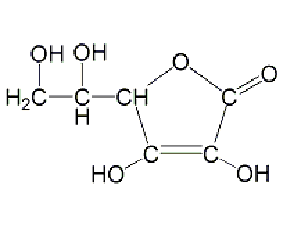
Structural formula
| Business number | 0147 |
|---|---|
| Molecular formula | C6H8O6 |
| Molecular weight | 176.12 |
| label |
Vitamin C, Vitamin C, ascorbic acid, 2,3,4,5,6-pentahydroxy-2-hexenoic acid-4-lactone, L-Threoascorbic acid, Antiscorbutic vitamins, Vitamin C, L-Ascorbic acid, 3-Oxo-L-gulofuranolactone, Antioxidants, food nutritional supplements, chromatographic analysis reagents, Ester solvent |
Numbering system
CAS number:50-81-7
MDL number:MFCD00064328
EINECS number:200-066-2
RTECS number:CI7650000
BRN number:84272
PubChem number:24891042
Physical property data
1. Character: Usually flake, sometimes needle-shaped monoclinic crystal. 2. Density (g/mL, 20/4℃): 1.954
3. Relative vapor density (g/mL, air=1): Undetermined
4. Melting point (ºC): 191 (Microdecomposition)
5. Boiling point (ºC, normal pressure): 1.65
6. Crystalline phase standard combustion heat (enthalpy) (kJ·mol-1): -2339.8
7. Crystal phase standard claims heat (enthalpy) (kJ·mol-1): -1164.6
8. Flash point (ºC): Undetermined
9. Specific rotation (º): [a] 25/D+20.5°-+21.5°(c=1)
10 . Autoignition point or ignition temperature (ºC): Not determined
11. Vapor pressure (kPa, 25ºC): Not determined
12. Saturated vapor pressure (kPa, 60ºC): Undetermined
13. Heat of combustion (KJ/mol): Undetermined
14. Critical temperature (ºC): Undetermined
15. Critical pressure ( KPa): Undetermined
16. Log value of oil-water (octanol/water) partition coefficient: Undetermined
17. Explosion upper limit (%, V/V): Undetermined
18. Lower explosion limit (%, V/V): Undetermined
19. Solubility: Easily soluble in water , slightly soluble in ethanol, insoluble in chloroform, ether, benzene, petroleum ether, oils and fats.
Toxicological data
1. Acute toxicity: LD50: 5000mg/Kg (oral in rats)
Ecological data
None
Molecular structure data
For antioxidants, include processed fruits, vegetables, meat, fish, dried fruits, soft drinks and beverages. Added to pure fruit juice, it can maintain the flavor for a long time and strengthen vitamin C; added to cans and syrups, it can prevent peaches, apricots, cherries, etc. from changing color and taste when canned; added to beer and carbonated water, it can prevent oxidation and flavor deterioration. It can also be used as a wheat flour improver.
2.Reagents for the determination of arsenic, iron, iodine, bismuth, calcium, magnesium, titanium, tungsten, antimony and phosphorus. Reference material for acid anhydride determination. Also used as nutritional supplement and antioxidant.
3.Used as antioxidant and food nutrition fortifier. It can be used for fermented flour products, the maximum usage amount is 0.2g/kg; it can also be used for beer, the maximum usage amount is 0.04g/kg :Arial;”>g/kg.
4.Vitamin C participates in the body’s complex metabolic processes and can promote growth and enhance resistance to disease. This product has strong reducing properties and can be used as an antioxidant. When vitamin C is lacking, wounds or ulcers are not easy to heal, bones and teeth are easily broken, and scurvy symptoms occur: capillary permeability increases, the fragility increases, and it is easy to rupture and bleed; in severe cases, muscles and internal organs bleed, leading to death. Our country stipulates that it can be used to strengthen sandwich hard candies, and the usage amount is 2000~6000mg/kg; in high-speed iron cereals and their products (eat 50g of such foods per day) The dosage used in fortified infant foods is 800~1000mg/kg; the dosage used in fortified infant foods is 300~500 ;”>mg/kg; used in fortified canned fruits at a dosage of 200 to 400mg/kg; used in fortified liquids and milk drinks The dosage used in fortified fruit puree is 120~240mg/kg; the dosage used in fortified fruit puree is 50~100mg/kg “>mg/kg.
5.Vitamin C participates in the body’s complex metabolic processes, can promote growth and enhance resistance to disease, and can improve poultry production. Egg volume and improved egg shell quality. When animals are deficient in vitamin C, they will suffer from symptoms such as loss of appetite, growth stagnation, dull coat, and anemia.
6.Used as analytical reagents, such as reducing agents and masking agents. Used as chromatographic analysis reagents.
7.Used as an antioxidant in cosmetics and food to prevent pigmentation (old spots, freckles, chloasma) . The dosage in cosmetics is 0.1% to 0.5%, and the dosage in food is 0.005% to 0.5%.
8.Ascorbic acid is used in zinc-iron alloy plating, nickel-iron alloy electroplating solutions, precious metal chemical passivation solutions, and can also be used in solutions chemical analysis.


